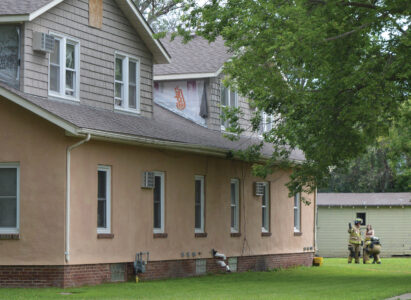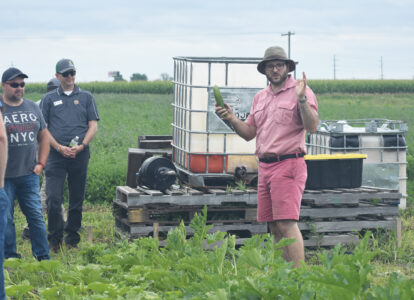Cooperative considers special-needs learning center in Marshall
MARSHALL — At the work session meeting on Monday, Marshall School Board members learned that Marshall is one of six locations that Southwest West Central Service Cooperative identified for potential capital investment projects.
Cliff Carmody, executive director for SWWC, presented information regarding the planning process in which Marshall, Cosmos, Windom, Pipestone, Montevideo and Willmar were identified as locations for the capital investment projects — at a combined total of $40 million-$50 million — for developing or repurposing current facilities for meeting the needs of students with special needs.
“We’ve identified these six sites for a couple of reasons,” Carmody said. “Believe it or not, access to food service is really critical. We need partners who are going to help us in food service. Law enforcement and the support of law enforcement are also important for our programs. And then like everything, it’s hard to recruit staff — the labor market is really tough right now and I don’t think that’s going to change — so we think and believe that recruiting staff to a regional center may be easier than recruiting staff to some of these smaller communities.”
The estimated cost for a learning center in Marshall is $7 million. SWWC has been in discussion with the city of Marshall and Southwest Minnesota State University about a possible collaboration.
“Marshall is on our list and we will move to Marshall,” Carmody said. “We’ve had some preliminary conversations. We’ll look at what exists, what the possibilities are and what collaborations we can come up with. I understand you all have plenty of facility issues with your own work, so it’s hard for me to come in and ask for a portion of those dollars to be used on some programming.”
With six communities identified, the overall project is expected to take several years to complete.
“It’s a multi-year plan,” he said. “We’ve identified the $40-$50 million in work that needs to be done to get this started, but we’re not going to do this all overnight.”
SWWC is one of nine service cooperatives in Minnesota, covering 18 counties in the southwest and west central part of the state.
“It’s a big region and we provide a high level of programs and services,” he said. “We are the most comprehensive (of the nine service cooperatives), and quite honestly, although we do serve cities, counties and other governmental units, the majority of work is with schools. It’s just what we do.”
In his presentation, Carmody said he appreciated hearing the board recite its mission — to educate, support and prepare all learners for success — prior to every meeting.
“I love that you talk about it because your mission is our mission,” Carmody said. “We feel very strongly about that –that our job is to support and enhance your work as we do what we do, which is to provide programs and services that meet your needs.”
SWWC began the process for developing a baseline real estate and facility plan to address the facility needs of the service cooperative in September 2016. Carmody said it quickly became a program review.
“One of our guiding principles is to improve and expand services to students and members around the region,” Carmody said. “For example, our ‘Setting 4’ program for special education — it’s the least restrictive environment –and the higher the setting, the more restrictive it is.
Carmody estimated that students in the “Setting 4” program spend about 60 percent of their time outside the traditional classroom setting.
“They’re students that have a diagnosis of autism, very often, and severe emotional and behavioral issues, not unlike what we heard from the social workers and counselors (on Monday), although they’re not the same because you can have a severe emotional/behavioral needs and not be working with a mental health professional or vice versa,” he said. “Many of our students have these needs. We work very hard to maintain a minimal component in our programs, but it’s hard to do that because funding isn’t there.”
Though it’s a state organization, Carmody said they don’t receive any state funds at all directly from the state.
“We’re a state organization and we have statute laws to do what we do, but everything we do is fee for service,” he said. “It’s a different way. But I think we’ve still done a pretty good job of meeting the needs of school districts in the region.”
The biggest financial investment identified is a $10.5 million repurposing project in Cosmos.
“Our primary autistic program is in Cosmos,” Carmody said. “So we have students getting in a van and being transported 75 miles one way a day to get to the autism program. So we quickly said that isn’t going to work. So we said wherever we end up with the programs in the region, we want to make sure that the program access is the same for every school district as it is for those that are closest to Cosmos. So we’ve done that. We’ve expanded the program and as a result in the last three years or so, we’ve seen our enrollment grow by 10-15 percent every year.”
Currently, there are about 60-65 students being educated at the old school building facility in Cosmos.
“It works pretty well, but it’s not designed for students with ‘Setting 4’ needs,” Carmody said. “There are doors at the end of long hallways. Kids like to run and try to get out the doors. If there’s anything built in, they’ll find a way to get on top of that. They also like to break glass. So all of those things you have in a traditional elementary school that makes sense doesn’t always work well for the students we have in our programs.”
About two dozen Marshall students are currently served off-campus by SWWC. Carmody hopes that by school boards passing resolutions, basically confirming the necessity of these programs, it could potentially put some pressure on the state to chip in financially.
“You have these children in your buildings today,” he said. “(The legislators) know about them — some are in our programs, but our (current) programs are pretty full. It’s challenging because our service agency doesn’t have access to very good tools for us to recover some of the costs, particularly for long-term facility maintenance.”
Like the increasing needs for mental health, which district social workers and counselors shared with the board earlier in the meeting, special education needs have trended upward for many years.
“These children have needs and what we’re trying to do is build facilities that will help with those needs,” Carmody said. “Our staff does wonderful work. I appreciate the support that you have given us for these programs. They’re so needed and so necessary. These students deserve whatever it is that we’re doing for them. They should have an opportunity to learn, like all of our students have an opportunity.”



